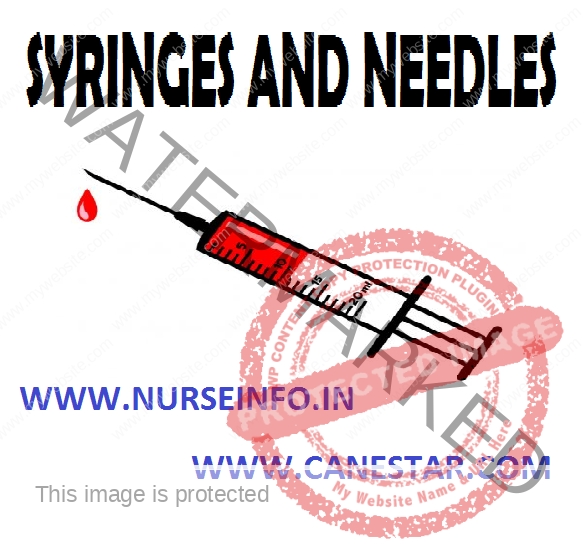SYRINGES AND NEEDLES
Drugs are administered as injections using a needle and a syringe. A syringe consists of a barrel and a plunger (piston). A type of syringe known as Luer-Lock syringe has the advantage that the needle can be locked in position. ‘Intravenous injections are given with the help of an infusion set’
Sizes: syringes are available in various sizes 1, 2, 5, 10, 20 and 50 ml. syringes may be of two materials – Glass and plastic
Glass Syringes
Advantages
- The markings are accurate and therefore exact quantity can be drawn
- The fluid level can be clearly seen as the glass is more transparent
- They can be easily sterilized by boiling and reused
- Glass syringe are resistant to punctures
Disadvantages
- Glass syringes do not break easily
- They carry a greater risk of air embolism because they are rigid
- They are more expensive. Glass syringes are no more preferred because of the risk of spreading dangerous diseases like AIDS when not properly sterilized
Plastic Syringes
Advantages
- Plastic syringes do not break easily
- Because they are collapsible, they allow proper emptying of the syringe – hence less risk of air embolism
- They are cheaper
- They are disposable
Disadvantages
- Plastic syringes are not very accurate in scale
- They cannot be easily sterilized
- They cannot be reused
Special Syringes
Insulin syringes has markings in units – (40 in 1 ml (red) or 80 in 1 ml (green) are suitable for administration of insulin
Tuberculin syringe is a syringe of 1 ml capacity with 0.01 ml markings. It is useful for administration of very small volumes
Disposable Syringes and Needles
Sterile disposable syringes are made of plastic and are packed with a needle to be fixed at the time of use
Advantages
They have the following advantages:
- Need no sterilization
- Injections are less painful as needle is sharp
- Convenient to use
Disadvantages
Works out costlier as they are not reusable
Needles
Needles are made of stainless steel, which is rust proof. The tip which is at the end of the shaft is beveled. The beveling may be short, very short or regular. Needle is available in different gauge thickness and length. The gauge numbness is from 13 (thickest) to 27 (finest). Depending on the route of administration, size of the patient and the thickness of the solution to be injected, the needle is selected


